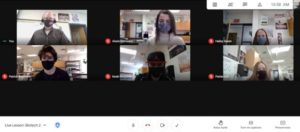Simultaneously Supporting Students In-Person and Online // Peter's Blog // March 25th, 2021
Friday March 13th, 2020. This was the last day of in-person instruction in my school district. I certainly will not forget all that transpired in the days after that and the rapid conversion to doing all things online. While I had been incorporating “flipped instruction” and “blended learning” in my classes for almost 10 years, teaching completely online still presented challenges. Within a span of two weeks, everything we taught was moved to Google Classroom. Google Meets and “I’ll throw the link into the chat” became the “new normal.”
And then, it was normal – as normal as it could get. While we were all hoping to re-open in the fall, the rapid rise in new cases made it apparent that we were in for more online learning – more of the same. As I have noted in previous posts, there were still plenty of challenges. But – whether you think it is the wave of the future or hate it with a passion – online learning was comfortable because we had already been doing it the previous 4-5 months.
So, that is how it went until we went back to school at the beginning of February. My district elected to offer in-person instruction in the morning and online instruction in the afternoon. I think that they have really done a great job with what amounts to a terrible set of options and what follows is not a critique of their decision. Nor is this meant to be fodder for people that want to bring back students to full day learning.
With those caveats noted: That first day back made it apparent that in-person teaching, while still following safety protocols, was very different. It is certainly different from online teaching, but it is also different from in-person teaching prior to the pandemic.
For me, in-person and online teaching require different skill sets, different approaches, different resources, a different flow . . . different everything. It doesn’t make one better than the other. Both approaches have their benefits and drawbacks. That isn’t the point.
In fact, the hard part in returning to school isn’t managing the additional issues of having students who are present for A days and some who are present for B days and some who get sick and others who need to quarantine for a week or two. By far, the biggest challenge is figuring out how to best teach both the online and the in-person students. For some sections, this has even meant two different Google Classrooms with different Google Meets and different assignments on different days.
It’s been 7 weeks since we returned, and I don’t really have an answer. That’s okay, we are changing our schedule to 4-day/week instruction with twice as many students in the classroom right after Spring Break so any answer I come up with now is already too late. On to the next challenge!
Doing labs with students in the classroom has been different than before, too. Normally, students might have a few resources at their lab bench, but most of what they need is scattered around the room. Since students have to watch their distance, now those resources are already at their table – their own individual lab table.
For example, a recent lab involved my Biotech students setting up a restriction enzyme digest and preparing an agarose gel. Tubes with DNA and enzymes were at their lab bench when they arrived, as well as a flask with a pre-weighed amount of agarose and a bottle of pre-measured TBE buffer. To melt the gel, they went individually go to the microwave rather than stand in line. These changes did not require any significant additional time nor did they really require any significant changes to lab prep on my end. It was just different – appropriately geared to satisfying current safety protocols. Of course, these guidelines are also changing with the new guidance stating that 3 feet of distance is okay (for students) instead of the previous six feet. New challenges again. In the end, that is part of what this pandemic has taught me – how to deal with challenges. And as we learn more about this disease and as vaccines become available, new situations will present different challenges yet again. In my next post, I plan to talk about what I would like to keep utilizing from this past year of change. But until then, I will be busy figuring out how to make adjustments one more time… and so will my colleagues and all of our students.
